The woodland walk is a fairly new addition to my garden but I’ve been amazed how quickly it’s come together. Can we really have conjured this place in just two years from a back area in the garden covered in nettles?
At this time of year, spring, the daffodils dominate and lighten the area in splashes of white and golden yellow but look closely and there are other treasures emerging.
Trillium albidum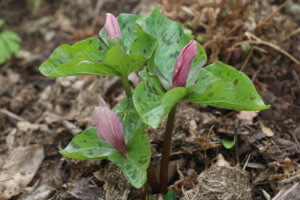
I planted this Trillium only a year ago and one flower has become three. Will I have nine next year? I hope so as it has a lovely upright shape, and speckled leaves arranged around the flowers in groups of three. This variety is also called the Giant White Wakerobin but mine have a strong pink blushing. I’ll be interested to see if the blushing fades as the flowers open.
Sanguinaria canadensis – Bloodroot
This plant is native to North America, seems extremely robust and is spreading well in my garden. Planted from a 9cm pot eighteen months ago, the roots now cover an area the size of a large dinner plate and are supporting several pure white flower heads. I love the way that the leaves curl round the emerging buds, cuddling them as the start opening. When the flowers do open they have a stunning waterlily shape as the one I have growing is a double form.
The common name of this plant is bloodroot and allegedly the roots are beetroot red when cut. I’m so happy with how my plant is performing I’m yet to try this but maybe one day curiosity will get the better of me.
Anemone nemorosa – Wood Anemone
One of the most searched for articles on my blog at the moment is about how to plant wood anemones. Up until recently I felt a bit of a fraud for this since mine, planted 18 months ago, were seriously underperforming. This was to be expected though as they are known to be very slow to establish. However, the first flowers have begun to emerge on my plants and whilst I’d say the display still falls short of its full potential, in a few years it could be wonderful. The flowers are delightful.
Primula elatior – Cowslip
This mass of yellow primula flowers on long stems is a result of seed sown from the Alpine Garden Society Seed Exchange in 2019. I think the clump could be split later in the season but for now I’m enjoying the frothy pale yellow mass glowing in the evening sun.
Narcissus Thalia
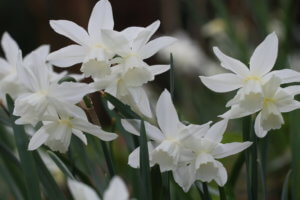
These daffodils are very popular and it’s easy to see why. The matching white coronas and sepals light up a shady area and there’s something about the delicate shapely petals and corrugated corona fluting that means the first adjective to spring to mind is invariably “charming”.
Can you have too much of a good thing? I do think I probably planted too many of these down in the woodland but they put on a fabulous show. I think I will thin a few out so that they are in more distinct groups and so that I can plant a few new spring plants in between.
Narcissus cyclamineus ‘Rapture’
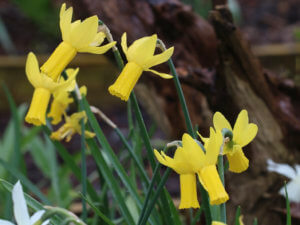
A feature of cyclamineus narcissi is the swept back petals – reminiscent of a spaniel with its head out of the car window. I like the pure golden yellow of these and they are a good counterpoint to the white Thalias.
This seasonal diary is part of a weekly link-up of garden bloggers from around the world, called Six on Saturday. For more information and links to other blogs crammed with gardening activity, check the blog of host The Propagator.

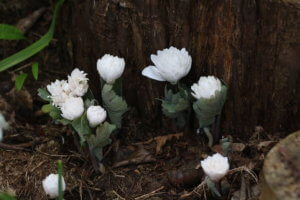
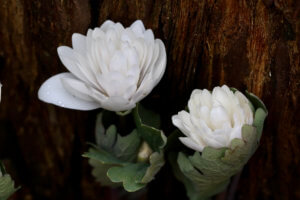
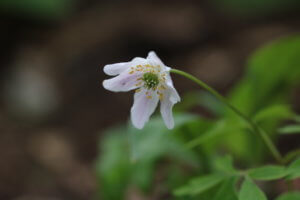
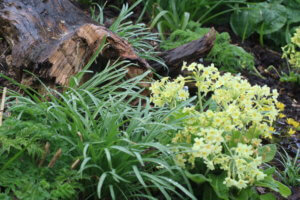
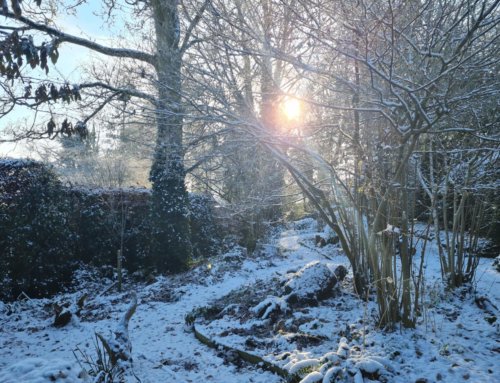
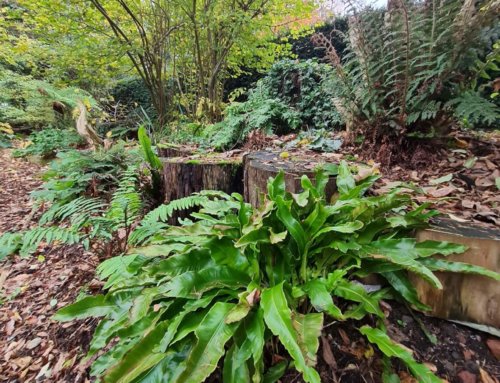
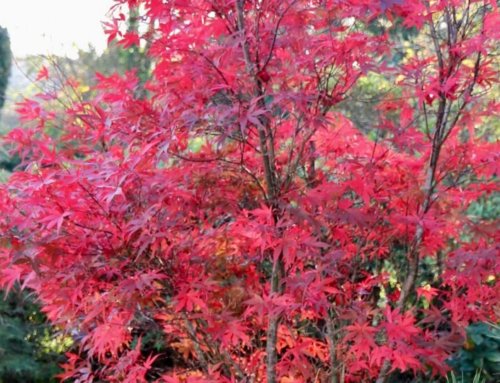
The Sanguinaria could hardly be described as robust so it is simply doing very well for you. The pink on T. albidum is quite strong. I find some plants have a pink streaking close to the base while others are a clear white, a good plant.
Hi Paddy – thanks for letting me know about the pink streaking on the Trillium albidum. I was worried it had been wrongly labeled when I bought it but couldn’t find anything else it could be. I really like it and it seems happy where it’s planted. As for the Sanguinaria I’m so pleased it likes it in my garden!
Glad to see Sanguinaria likes to grow in your garden. I’ve never seen them in the gardens near home (and I’ve never tried them here either)
I first saw a sanguinaria on twitter and was beguiled. Just 2 weeks later I saw a large clump growing at the RHS Gardens at Wisley. I found some sold by Scottish alpine and woodland specialist nursery Kevock Plants and have been so happy with them.
I love love love the sanguinaria, how beautiful! Lots of favourites here, trillium, Thalia, just beautiful.
Thanks Gill – I go down there regularly and sometimes have to pinch myself at how pretty it looks. Sanguinaria is a real winner – the leaves are a fabulous shape in summer. I’m surprised it’s not better known or mode widely grown…
I was going to comment on the Sanguinaria as well but will give a shout out to the Trillium instead. I hope its flowers do continue to multiply in 3’s! Funnily enough Monty Don was talking about Wood Anemones the other week and mentioned that they can take a while to spread. Very pretty.
I saw Monty’s wood anemones and was rather envious. Mind are definitely coming on but it is not a quick win. I too am delighted with the Trillium and I hope it continues to thrive.
Really, I cannot think you can have too many Thalia!
You are right Megan. It’s a thoroughly delightful daffodil and I’ve got enough to cut some for the house too!
Wow. What a lovely collection of flowers. I have been curious about bloodroot for a while now, and your photographs have persuaded me to try to get my hands on some. I particularly appreciate your description of leaves “cuddling” the flowers as they begin to open. The cowslip’s diminutive flowers are so much more appealing to me than the larger flowers of the specimens I have seen before. It is a mass effect, as you say a “froth” that manages to be eye-catching yet delicate in the way that woodland flowers should be.
Hi Erin – I hope you track down a bloodroot. I think I originally saw some pictures on twitter and was entranced by it. I know what you mean about the cowslips – they really clump together as if they like behind close to their friends – hence the froth. No social distancing for the cowslip!
Your woodland border is looking fabulous. The bloodroot is a great looking plant. I’m impressed that you’ve created all this in two years. I’m still very much fighting back the nettles here.
I’m amazed we’ve kept the nettles at bay. My problem is encroaching ivy now but I just need to remove it little and often.
Love the first photo of the Thalia en masse, it has real impact and I think white is the perfect colour for woodland. Like your description of the spaniel with its head out of the window for the cute Narcissus C. Rapture, I see it!
Cyclamineous are often described as looking like they’re in a wind tunnel but once you’ve though spaniel, you can only think spaniel!
The Sanguinaria is a new one to me. It’s very nice indeed.
It’s good to see the Trillium growing well for you – I know they can take a while to settle sometimes.
Sanguinaria is one for the list Andrew. The leaves in summer are a fabulous shape too so it’s a good all rounder.
Sanguinaria canadensis – Bloodroot is an absolute charmer, and I love your description of how the leaves curl round.
Hi Noelle, Last year I didn’t notice how the leaves curl around the sanguinaria flowers, probably because last year’s heat sped up the flowering process. These have been opening in slow motion this year because it’s been so cold.